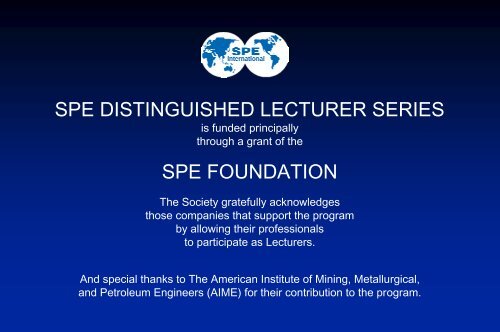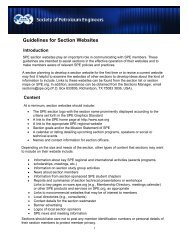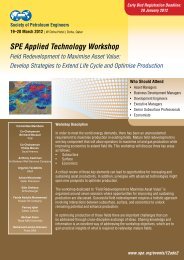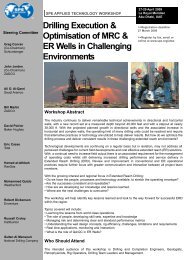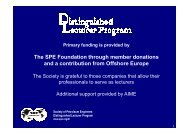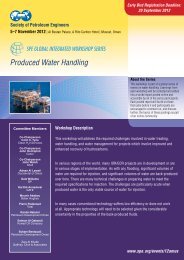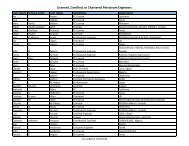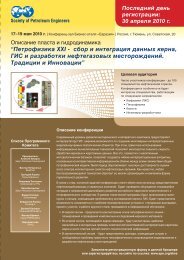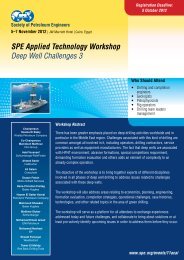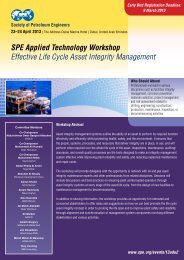Rashid Khan 2006-07 SPE Distinguished Lecture - Society of ...
Rashid Khan 2006-07 SPE Distinguished Lecture - Society of ...
Rashid Khan 2006-07 SPE Distinguished Lecture - Society of ...
Create successful ePaper yourself
Turn your PDF publications into a flip-book with our unique Google optimized e-Paper software.
<strong>SPE</strong> DISTINGUISHED LECTURER SERIES<br />
is funded principally<br />
through a grant <strong>of</strong> the<br />
<strong>SPE</strong> FOUNDATION<br />
The <strong>Society</strong> gratefully acknowledges<br />
those companies that support the program<br />
by allowing their pr<strong>of</strong>essionals<br />
to participate as <strong>Lecture</strong>rs.<br />
And special thanks to The American Institute <strong>of</strong> Mining, Metallurgical,<br />
and Petroleum Engineers (AIME) for their contribution to the program.
Crude Value Enhancement: An Emerging<br />
Opportunity for Innovations in E&P?<br />
M. <strong>Rashid</strong> <strong>Khan</strong><br />
<strong>Rashid</strong>.khan.1@aramco.com<br />
2
Boom and bust: Perception <strong>of</strong> our mind?<br />
March 1999 $10/bbl<br />
Oct 2003 $46/bbl<br />
3
All major organizations missed<br />
Oil price forecasts in1998<br />
$/BBL (1996 Dollars)<br />
35<br />
30<br />
25<br />
20<br />
15<br />
Widely Divergent Forecasts<br />
Make Planning Difficult<br />
IEA<br />
DOE High<br />
Mobil<br />
DRI<br />
DOE Base<br />
Nat. Res. Canada<br />
10<br />
2000 2005 2010 2015 2020<br />
Year<br />
U.S. Department <strong>of</strong> Energy, 1998<br />
Nat. West Sec.<br />
Pet. Econ. Ltd.<br />
DOE Low<br />
4
Faults Aug, 2005<br />
Many books on the topic...<br />
>$70<br />
5
There are many suggested peaks<br />
“Which peak you wish to pick?”<br />
6
Topics<br />
• Innovation and historical trends in energy usage<br />
• Crude oil quality and its impact on subsequent use<br />
-“bad actors” or undesirables in crude?<br />
- human impact on quality? standards <strong>of</strong> “crude<br />
oil”?<br />
• Relation between quality and price<br />
• Traditional upgrading/desulfurization processes?<br />
• Motivation for field upgrading<br />
• Opportunity for innovation<br />
7
Crude reality<br />
• Is the industry innovative?<br />
• What investment typically goes into production vs. processing?<br />
Where the Gas Dollar Goes?<br />
Refining 20%<br />
Distribution &<br />
Marketing 8%<br />
Federal, State &<br />
Local Taxes 20%<br />
Crude Oil 52%<br />
US DOE<br />
8
Is the industry innovative?<br />
Relative R&D performance <strong>of</strong> Industry leaders for 2003<br />
Pharma/biotech*: $14 b<br />
Intel & Micros<strong>of</strong>t: $11.5<br />
General Motors: $6<br />
Global oil and gas**: $3<br />
US Oil & Gas total***: $
Does crude oil quality matter?<br />
• Crude oil must be converted yet there is “brick wall” when<br />
discussing crude quality<br />
• Quality is impacted during or after production<br />
• Sulfur and gravity do NOT adequately define crude<br />
quality; other “bad actors” also impacts crude quality<br />
10
“Bad-actors” – undesirables in crude oil?<br />
• Sulfur, Density (API(<br />
Gravity)<br />
• Total Acids (TAN)<br />
• Nitrogen, BSW (bottom, sediment, water)<br />
• Viscosity, Boiling Point<br />
• Carbon residue, metals<br />
• Dissolved H2S or elemental S<br />
• Contaminants introduced<br />
• Precursor for green-house gas<br />
(more later)<br />
• Every crude oil is unique<br />
11
Definitions and impact<br />
•Sulfur:<br />
Less than 0.7% S = sweet; >0.7 %S = sour, require more<br />
processing<br />
•Acid:<br />
Acidic Crudes (>TAN 1) are highly corrosive at various areas<br />
•Density (API gravity): Light crudes are easier to process<br />
Viscosity (cP)<br />
10 100 1,000 10,000 100,000<br />
Conventional<br />
Crude Oil<br />
Heavy<br />
Crude Oil<br />
Extra Heavy Oil<br />
(Tar Sand Oil &<br />
Bitumen)<br />
35 20 15 10 5<br />
Gravity ( o API)<br />
12
Quest for quality<br />
All data show that most new global capacity is sour and heavy<br />
33.5<br />
33<br />
32.5<br />
32<br />
31.5<br />
31<br />
30.5<br />
30<br />
29.5<br />
29<br />
API Gravity Sulfur %<br />
28.5<br />
1984 1987 1990 1993 1996 1999 2002<br />
Source: EIA<br />
1.6<br />
1.5<br />
1.4<br />
1.3<br />
1.2<br />
1.1<br />
1<br />
0.9<br />
0.8<br />
0.7<br />
0.6<br />
USGC million bbl/day<br />
10<br />
9<br />
Light Sweet Light Sour Heavy Sour Hi TAN<br />
8<br />
7<br />
6<br />
5<br />
4<br />
3<br />
2<br />
1<br />
0<br />
1985 1990 1995 2000 2005 2010 2015<br />
13
Quest for “ultra clean” fuels<br />
diverted capital<br />
14
Factors impacting crude price<br />
• Declining crude quality<br />
• Changes in product<br />
quality specifications<br />
• Little spare crude oil<br />
processing capacity<br />
• Investment constraints<br />
• Demand outpacing<br />
supply<br />
May a Discount from W TI ($ /bbl)<br />
25<br />
20<br />
15<br />
10<br />
5<br />
0<br />
Jan-99 Jan-00 Jan-01 Jan-02 Jan-03 Jan-04 Jan-05<br />
15
From production to refinery<br />
Human factors impacting quality: “dilution is the solution to pollution”<br />
• “Crude oil” does not have strict “quality standards”<br />
• Contamination: Cleaning waste, chlorinated solvents, NG liquids<br />
• Alternation: Completion & drilling fluids, production chemicals, additives, etc.<br />
• Blending: Some are not transparent.<br />
• “Dilution is NOT the solution to pollution”<br />
16
,<br />
Comments from Crude Quality group<br />
“We are concerned with the increased blending crude with foreign<br />
Sour to sulfur and gravity limits and representing them as neat<br />
domestic barrels. We are hoping to come to an agreement to push<br />
the entire industry to report on a routine basis on all barrels<br />
traded. We hope the traders will no longer merely trade on gravity<br />
and sulfur…..”<br />
Dr <strong>Khan</strong> ……. I would be interested to know the E&P feedback to<br />
the downstream on what additives are present in crude oils and<br />
…evaluate impacts <strong>of</strong> existing and new chemical additives….<br />
Dr. <strong>Khan</strong>,… the industry has yet to develop a full understanding <strong>of</strong><br />
the performance <strong>of</strong> crude oil after it has been significantly changed by<br />
the production process.<br />
17
Crude quality may have many implications<br />
• Corrosion: main cause <strong>of</strong><br />
pipeline failures<br />
• Case study: costs <strong>of</strong><br />
pipeline corrosion: $5 -9 b/y<br />
• In one pipeline alone in<br />
USA required > $1b<br />
18
Options for crude upgrading<br />
1. In refinery (current) “in<br />
your backyard.”<br />
2. Field upgrading<br />
3. In-situ, down hole<br />
More field upgrading, less refining<br />
• Crude is generally converted near the<br />
population centers.<br />
• Integration with production may<br />
provide synergy, be less energy<br />
intensive and be cleaner.<br />
• Leave “bad-actors” at the source.<br />
World's first floating gas refinery<br />
19
Science for crude upgrading<br />
Add<br />
Hydrogen<br />
Remove<br />
Carbon<br />
crude<br />
Novel Processes<br />
Combinations<br />
20
Fundamentals <strong>of</strong> carbon rejection<br />
Coker<br />
Cracking<br />
Unit<br />
Thermal or Catalytic<br />
Key<br />
Residual<br />
Heavy Gas Oil<br />
Intermediate<br />
Each dot represents<br />
4 carbons<br />
Heavy Gas Oil<br />
Gas Oil or Diesel<br />
Kerosene<br />
Processes: Visbreaking, Steam cracking, Fluid Cracking, Coking<br />
Key<br />
Gasoline<br />
Each dot represents<br />
4 carbons<br />
21
Fundamentals <strong>of</strong> hydrogen addition<br />
• Cracking in the<br />
presence and H2H<br />
• Reactions catalyzed<br />
by metal sulfides<br />
Processes<br />
Hydrocracking, Hydrovisbreaking<br />
22
Defining refining<br />
800 o<br />
Residual Fuel<br />
Oil/Asphalt<br />
Further Processed to Gasoline<br />
Diesel, Fuel Oil& Lube Stock<br />
23
Crude types vs products<br />
Crude Types<br />
Characteristics<br />
Yields<br />
2004 U.S. Refinery Production<br />
Sweet Crude<br />
(e.g., WTI, Brent)<br />
34+ API Gravity<br />
0.7% Sulfur<br />
Less Expensive<br />
0.7% Sulfur<br />
Least Expensive<br />
3%<br />
21%<br />
26%<br />
50%<br />
1%<br />
14%<br />
22%<br />
63%<br />
49% Gasoline<br />
RFG<br />
Premium<br />
32% Distillate<br />
Jet Fuel<br />
Diesel<br />
Heating Oil<br />
11% Heavy<br />
Fuel Oil<br />
& Others<br />
24<br />
Source: IEA
Many field treatment are already viable<br />
Remove H2S H S in crude oil in the field; viscosity reduction<br />
• Sour crude have high elemental S (>0.5%), dissolved H2S H<br />
• Maya, Qatar, W. Texas: 200 -350 ppmw<br />
• H2S S is removed in the field strippers, desalters or holding tanks, but elemental S<br />
may remain; the easiest way to remove is by upgrading (T, t, catalysts).<br />
alysts).<br />
1000<br />
Actual Data<br />
H2S S Concentration<br />
1400<br />
Lowering crude viscosity in field?<br />
V A P O R S P A C E C O N C (P P M<br />
900<br />
800<br />
700<br />
600<br />
500<br />
400<br />
300<br />
200<br />
VAPOR<br />
100 PPM<br />
CRUDE OIL<br />
1 PPM<br />
WATER<br />
10 PPM<br />
cP<br />
1200<br />
1000<br />
800<br />
600<br />
400<br />
200<br />
0<br />
Fuel<br />
Petroleum Sludge<br />
5, 100 15, 200 25, 300 35, 400 45, 500 55, 600<br />
sec, sec-1<br />
100<br />
Processed<br />
Raw<br />
0<br />
1 2 3 4 5 6 7 8 9 10 11 12 13 14<br />
LIQUID CONC (PPMW)<br />
Physical treatment eased transport<br />
US Patent Application 2004/0035749<br />
US Patent 6,444,117<br />
25<br />
24
Basic field upgrading to syncrude<br />
H2<br />
Feed + Catalyst<br />
Upgraded<br />
Products<br />
6<br />
Catalyst recycling<br />
Separ ation<br />
Percent Sulfur<br />
5<br />
4<br />
3<br />
2<br />
1<br />
0<br />
15 20 25 30<br />
API Gravity<br />
Gravity & sulfur during upgrading<br />
26
In-situ upgrading & recovery <strong>of</strong> 60% remaining oil<br />
Pipe dream?<br />
Upgraded<br />
crude<br />
Value enhancement<br />
Reactants<br />
Injection<br />
Gravel<br />
Injection<br />
Wells<br />
Producing Wells<br />
water<br />
Crude<br />
Production wells @ oil zone<br />
Limestone<br />
29<br />
CO2<br />
Water<br />
Gas<br />
Steam<br />
Chemicals<br />
Oxygen<br />
Inject into the reservoir to force<br />
additional crude out <strong>of</strong> the pores<br />
in the reservoir rock.<br />
Some additives may change<br />
asphaltene improving quality and<br />
yield.<br />
27
Integrated gasification: innovative bridge to the future<br />
Sweet crude, chemical, power without GHG emission possible today<br />
Residue C + H2O CO + H2 CO2 + H2<br />
Oxygen<br />
Combined Cycle<br />
Electricity<br />
Alternatives:<br />
Gasification<br />
Heavy Oil<br />
Gas & Steam<br />
Turbines<br />
Steam<br />
SOUR CRUDE<br />
Petroleum Coke<br />
Refinery<br />
Residues<br />
SULFUR<br />
REMOVAL<br />
Clean Syngas<br />
Hydrogen<br />
for upgrading;<br />
Chemicals<br />
Orimulsion<br />
CO2<br />
Natural Gas<br />
Gasification Power Systems<br />
Slag<br />
28
Field or “mine mouth” conversion <strong>of</strong> fuel<br />
Opportunity for CO2 sequestration while making a sweet crude<br />
45,000 ton earth-mover<br />
en route to an open-pit pit mine<br />
Gasifier Unit, Jan <strong>2006</strong>, Source: OPTI Canada Inc.<br />
29
Growing inventions on upgrading<br />
some <strong>of</strong> which may be useful near production site or in-situ<br />
131 131 patents patents<br />
‘downhole ‘downhole&<br />
upgrading’; upgrading’;<br />
181 181 patent patent<br />
applications applications<br />
24 24 patents patents on on<br />
‘ultrasound+<br />
‘ultrasound+<br />
desulfurization’;<br />
desulfurization’;<br />
21 21 applications applications<br />
Insulation<br />
CONVENTIONAL<br />
Heating element<br />
Sample<br />
MICROWAVE<br />
Microwave port<br />
Furnace<br />
Sample<br />
Insulation<br />
145 145 patents patents<br />
‘downhole ‘downhole&<br />
desulfurization’;<br />
desulfurization’;<br />
106 106 applications applications<br />
133 133 patents patents on on<br />
‘in-situ ‘in-situ&<br />
gasification’;<br />
gasification’;<br />
179 179 patent patent<br />
applications applications<br />
Metal shell<br />
Cavity<br />
30
Quest for disruptive or radical innovation<br />
in energy development<br />
Scientist’s<br />
IDEAL<br />
Increasingly Basic Research<br />
Pure Research<br />
(Bohr)<br />
Systematic<br />
Exploration<br />
(Audubon)<br />
Use-inspired<br />
Research<br />
(Pasteur)<br />
Applied Research<br />
(Edison)<br />
Viewing problems based<br />
on new fundamental<br />
understanding<br />
Increasing Applied R&D<br />
Contribution <strong>of</strong> technology to economic growth >50%. but this is primarily from<br />
PASTEUR QUADRA; Ref: Modified from Donald Stokes, “Pasteur's Quadrant”<br />
31
IT innovation made oil field into a digital factory<br />
$3/gal oil vs $5/gal soda<br />
Much <strong>of</strong> today’s s oil is “smart oil.”<br />
32
Finding and supplying crude oil is challenging<br />
Many innovative successes by E&P, but future successes may be different<br />
33
Huge conventional & non-conventional oil sources exist:<br />
Opportunity for E&P innovation in heavy &/or sour resources<br />
~6-8 Trillion barrels <strong>of</strong> oil in in place<br />
Produced<br />
Remaining<br />
Recoverable<br />
Enhanced<br />
Oil Recovery<br />
Target<br />
~7 Trillion barrels <strong>of</strong> oil in in place<br />
Oil Shales<br />
38%<br />
Tar Sands<br />
& Bitumen<br />
39%<br />
IEA<br />
Extra<br />
Heavy Oil<br />
23%<br />
Source: IEA World Energy 2004<br />
34
A major problem for all fossil fuels is green house gas<br />
From H<strong>of</strong>fert<br />
• Climate changes<br />
threaten the world<br />
• Our energy policy must<br />
account for it by<br />
innovations for CO2<br />
capture, sequestration<br />
• A major need is to<br />
separate the energy<br />
content from carbon<br />
present in fossil fuels.<br />
• World needs “disruptive<br />
innovations” to face the<br />
challenges.<br />
35
To survive we have to adapt and innovate<br />
"It is not the strongest <strong>of</strong> the species<br />
that survives, nor the most intelligent; it<br />
is the one that is most adaptable to<br />
change."<br />
-- Darwin (1809-82)<br />
Mother earth is getting sick<br />
36
Responsible energy alternatives and energy conservation<br />
OIL SANDS<br />
ULTRA-Heavy<br />
Crude<br />
Ethanol<br />
(0.8 b/d)<br />
Gasification<br />
GTL<br />
37
Innovation in oil discovery: lessen from wildcatters<br />
“While people think big oil finds<br />
big oil, over the years about 80%<br />
<strong>of</strong> the oil found in the US has<br />
been brought in by wildcatters.”<br />
WSJ, “Wildcat Producer Sparks Oil<br />
Boom in Montana,” 4, <strong>2006</strong><br />
38
Innovation in oil industry did “miracles”<br />
Lessens from Kern River: discovered in 1899<br />
• Kern River, after 43 years <strong>of</strong><br />
operation had “remaining reserve”<br />
<strong>of</strong> 54 million bbl.<br />
• In the next 43 years <strong>of</strong> life, it<br />
produced, not 54 but 730 million<br />
bbls.<br />
• In 1986, it had “remaining reserves”<br />
<strong>of</strong> about 900 million bbls.<br />
• Innovation will bring surprises to<br />
crude quality and reserves.<br />
Adelman, 1987<br />
39
Innovation with optimism is the solution<br />
“Everything that can be invented, has been invented.”<br />
-Charles Duell, Head, US Patent, 1899<br />
• Edison 1888: Genius is 99% perspiration<br />
• Pr<strong>of</strong> Dickey 1958: “We usually find oil in<br />
a new place with old ideas. Sometimes,<br />
we find oil in an old place with a new<br />
idea, BUT we seldom find much oil in an<br />
old place with an old idea. Several times<br />
in the past we thought we were running<br />
out <strong>of</strong> oil, whereas actually we were<br />
running out <strong>of</strong> ideas.”<br />
40
Concluding remarks<br />
• <strong>Society</strong> quests for cleaner environment & cleaner fuels<br />
• Crude must be converted to clean fuels, but there is no<br />
clear standards on crude quality.<br />
• Human factors impact crude oil quality.<br />
• Concerns are on yield and not on quality; refiners r<br />
are<br />
challenged by supply & capacity constraints.<br />
• The challenge: make cleaner products from poorer feeds.<br />
• Opportunities exist to synergize quality issues while<br />
addressing production.<br />
• Disruptive innovation is needed to provide cleaner energy<br />
& address carbon & quality aspects <strong>of</strong> fuels.<br />
41
Thank you<br />
Be the change you want to see in the world<br />
You are invited to the spectacular natural wonders <strong>of</strong> Arabian gulf<br />
<strong>Rashid</strong>.<strong>Khan</strong>.1@aramco.com<br />
Please send any comments or feedback<br />
42
Q. How human impacts quality during production?<br />
• There are a number <strong>of</strong> steps involved before a crude is shipped<br />
to the refinery: GOSP followed by pipeline, shipping tank,<br />
storage etc.<br />
• Contamination: Tank cleaning solvents, cleaning waste,<br />
chlorinated solvents, NG liquids. The cleaning solvent with HCl is<br />
very damaging to refinery<br />
• Alternation: Completion fluid containing salt water, production<br />
chemical containing acids , drilling fluids, drag reducers,<br />
additives, antifoam, etc.<br />
• Blending: Well head, refinery charge etc, but some are not<br />
transparent (separation <strong>of</strong> asphaltenes is one <strong>of</strong> the concerns).<br />
43
Steam/Solvent assisted processes<br />
1. Steam-Assisted Gravity Drainage<br />
and variations<br />
2. Vapor-Assisted Petroleum<br />
Extraction, VAPEX and<br />
variations. Advantages <strong>of</strong> solvent<br />
aided over steam only:<br />
• Lower capital needs<br />
• Lower emission<br />
• Lower water usage<br />
• Some quality improvement<br />
Ref: S. Gupta, EnCana Corp.<br />
44
Q. Examples <strong>of</strong> current EOR and in-situ upgrading options<br />
• THAI process converts 10 API oil to 20.6 API; converts asphaltene e in the oil.<br />
• CHOPS (Cold Heavy Oil Production with Sand) produces oil along with w<br />
sand.<br />
• PPT (Pressure Pulsing Technique) increases oil rates <strong>of</strong> the original oil.<br />
• IGI (Inert Gas Injection) injects inert gas with gravity drainage e for pressure maintenance'<br />
• SAGD (Steam Assisted Gravity Drainage) heats the oil to reduce the t<br />
temperature for<br />
vertical drainage, producing the original oil.<br />
• VAPEX (Vapor Assisted Petroleum Extraction): Can provide upgrading by leaving some <strong>of</strong><br />
the heavier components in the reservoir.<br />
Example <strong>of</strong> an in-situ combustion process<br />
45


